WATSON LAKE
What is going on with the Converter
As we leave we drove on we came first
through lots of forest and then of a lot of burned trees – we drove forever
through those old forest fire section. And as we drove we saw 2 bears a black
and a brown one. Paul went to the back and discovered that the converter had a
red light and the board made a noise… so what is going on. After resetting
everything we decided to drive on to the next parking – as we are kind of in
the middle of the highway close to the bears.
Also this morning there was a ladder
in the middle of the road right as a motorcycle guy came towards us, that was
close!!!
We enter the Territory of Yukon
And then we hit the sign: you are
Leaving BC and there comes the Sign Yukon – larger than life. We stop and Gine
reads about the wildfires and Paul tries to get the converter fixed (he is not
so eager for Gine’s input). Ok so far we did not got it fixed – we have to see
what we are doing as we go on.
- In 2010 and 2011 two large wildfires occurred, lightning storms sparked the fires and they grew quickly due to the wind: the highway was both times closed
- The fires were allowed to burn naturally in most area – except close to the highway
- Fire in this area is a natural part of the forest life-cycle: the suppression of fires has led to a build-up of forest fuels which makes the fires more intense and severe. Fires remove the build-up of fuel which will create a natural fire break for future fires: the areas burned in the 2010 fire provided a natural firebreak for the 2011 fire
- Wildfires create a mosaic: which create biodiversity of the forest with different tree types and ages they support more life and it creates natural fire breaks
- New growth: fire returns nutrients locked in the plants and decomposing matter to the soil in the form of ash- an ideal environment for new plants to grow – this also leads to the return of wildlife
- It thins out the forest and makes grassy area and shrubs and is also more resilient to disease and insect infestation
First stop at Watson Lake
And then we come to the Alaska highway
– big difference from a local narrow road we enter the big wide Alaskan
highway. We have a few important stops in this major town after the long
stretch: #1 filling up gas, #2 dumping: and if you will up with Tags gas then
you can dump there for free (we didn’t really found the main dumping, so we
pulled into one of the many empty RV’s sites, dumped and filled all up). #3:
shopping – we didn’t got the oatmilk as it was not only 9$ but also only the
refrigerated version - let’s hope the
next store is a bit better. And no we are not hitting a big town soon, as the
population in the Yukon is not that large.
#4 we checked out the RV site, as we
thought it would be good to fully charge over night – they literally wanted 54
$ to park on a gravel parking lot like sardines – I think we don’t need to
charge up.
The Trader of Watson Lake:
- In 1898 the 14year old Frank Watson came with his father to the Yukon and they had a successful goldmine outside of Dawson City, but like many others their mine was flooded out in 1905. A few years later he returned and came by the Liard River Valley and met Adele Stone a Kaska Woman: because of his relationship with her he was allowed to trap and settle in the area
- We are in Kaska Dena territory – they are big into fishing - makes sense with all those lakes
- It is the 1st major BC settlement on the Alaska Highway: “It’s the gateway to the Yukon” - in the 1930s a great circle route was set up by air from, Edmonton to China and one of the airports was here: the Northwest Staging route
- By the way the original town was around the airport – only with the intersection of the Alaska highway the town “Wye” started up and grew into Watson Lake. Also in 1946 the Canadian Army took over the airport when the US Army departed and the military presence declines and in 1961 the communities buildings were demolished and moved to Watson Lake
- Yes the oldest building in town is from 1942, not that old when you really think about it
- Today here live 1500 people and it is the 3rd largest town in the Yukon (this makes it a bit more complicated as Paul said we should change the oil: but then we got the names of 2 guys and one of them will do it tomorrow morning – super!!!)
Internet at the Visitor Info
Our next stop was the Visitor info to
get some info and as well get free internet. Even better they have plugs so we
could start to charge our laptops (no converter no charging). It was nice to be
in contact with the outside world. Here we also discovered that you can have a
free shower – but not today as it is a STAT holiday – ok that is our #1 on the
plan for tomorrow morning.
How many people live in the “towns”
here?
- Ok so when you look at the map it looks like there are several towns until you look a bit closer: The whole of Yukon has 43.000 inhabitants and 34.000 live in Whitehorse
- Dawson City with 2200 is the 2nd largest and then comes Watson Lake with 1500That means all the other towns are fairly small: most of them have around 400-600 people, some of them even smaller
Getting lost between the sign posts
Finally it is time to hit the
highlight of Watson Lake: the Signpost forest:
- Here are 0ver 100.000 signs as per April 2022
- During WWII and the construction of the Alaska Highway the US Army posted directions to various locations in Yukon and added New York, Chicago and Tokyo. The homesick Cal Lindley was ordered to work on damaged signposts and taking the task to heart set up his own signpost to his Illinois hometown: his signpost grew into a forest. In 1992 he came back with his wife Eleanor for the first time since he left here in 1943 he replaced his original Danville / Illinois sign
- Cal said “I received an injury an injury near the border of BC and the Yukon My foot was smashed while building a platform to fill dump trucks, I was taken to the Company aid station near Watson Lake where I spend the next weeks recuperating. Not able to do much, the CO asked me to the repair and repaint the sign that had been run over by bulldozers and I asked if I can add my hometown Danville as I was homesick for my hometown and my girlfriend Eleanor”
- You can still the original mile post which is the only surviving one
- Gertrude who is the 1938 international TD 35 tracotr worked for 40 years here in the Yukon including the Alaska highway construction
- And can you believe it the sign forest is now a Yukon historic site
We walked all over and between – it is
impossible to look at them all – sometimes you look and let the whole lot of
signs come to you and then you look at some more individual signs and read them
– where are people coming from. Really cool. You could play hide and seek here.
As there were so many mosquitos Gine went back to get some mosquito repellent and
then we had more fun.
Checking out the Mosquitos at the lake
Paul said let’s check out the town –
but the town is not very big, so Gine said let’s go to the Watson Lake – I mean
to the actual lake – we drove there and were not even 5 Min there to enjoy the
lake because you heard them super loud and when you looked there were thousands
of mosquitos flying around – we never seen something like that. We will
definetly not stay here and turned around and went back to town.
An afternoon full of organizing
We have sunshine and Gine said she
needs to plan a bit – like checking where to go and when to be where – and then
booking the ferry from Skagway to Haines, as she learned today, that the ferry
only goes a few times a week. Supper on the picnic table in front of the
Visitor info – more internet time and computer time and we are ready to retire
to our camper for the evening – yes it is right: it’s windy and it started to
rain.
And we did stay right in front of the
sign post forest for the night
Getting the truck ready not us
This morning we were looking forward
to a nice shower – but then we discovered that it is 6.30 $ and we decided no
that is a bit pricy and we can make hot water all by ourselves. We had
breakfast and did a bit more of Sign post discoveries.
Next stop was to get some oil at the
store (ok even that is a bit pricier than at home) – then we called the car guy
to get our oil changed: first we didn’t know if we were in the right spot at it
was kind of in the no-where and it looked more like a junkyard: greeted by the
dogs we went to check out the old cars – what a shame to see them all going
rusty here. And then we are on the road again.

 Watson Lake, Yukon, Canada
Watson Lake, Yukon, Canada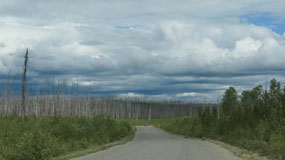
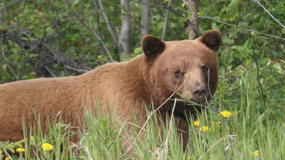
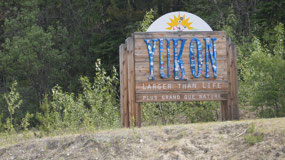
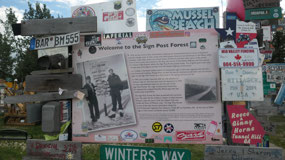

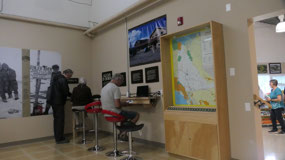
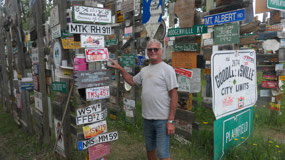
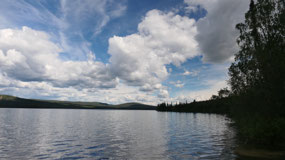
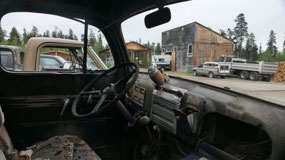


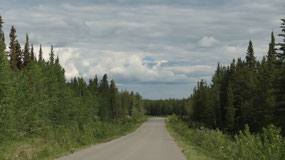
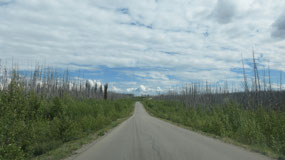
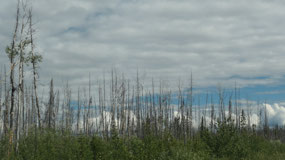
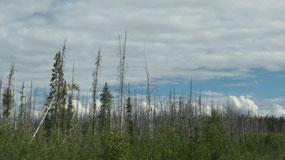
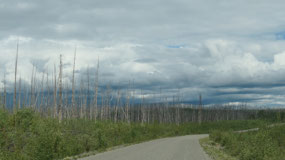
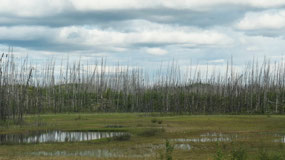
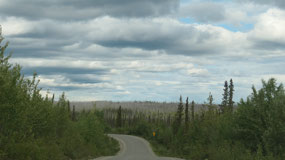
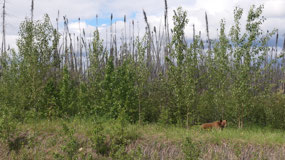
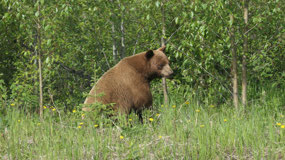
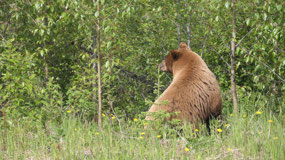
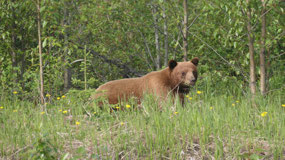
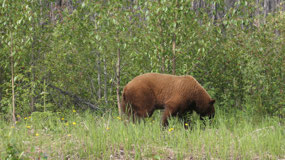
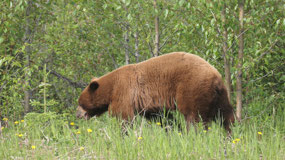



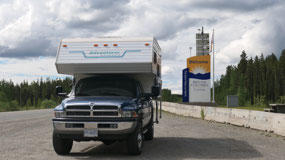
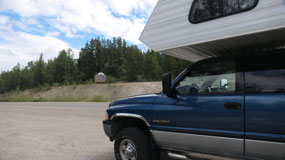
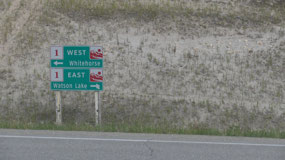
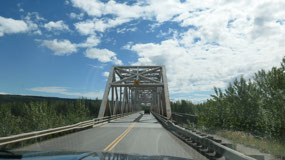
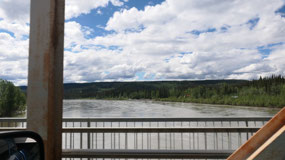
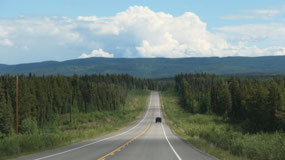

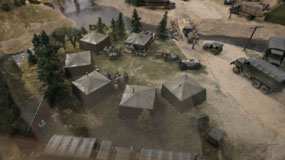
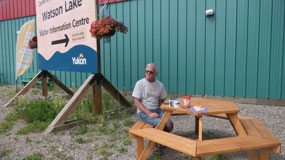
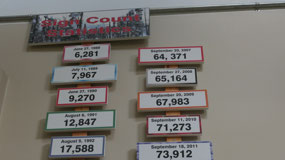
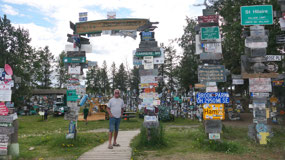
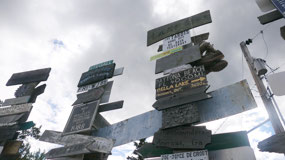
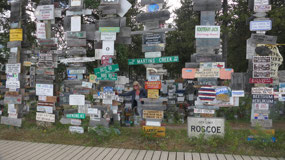
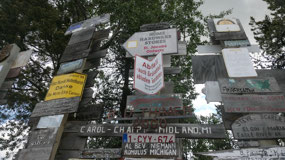
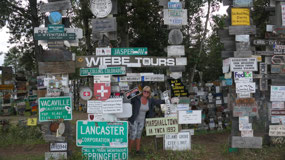

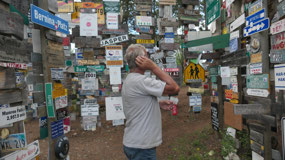
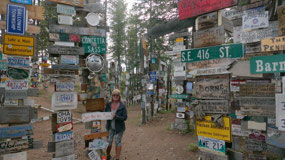
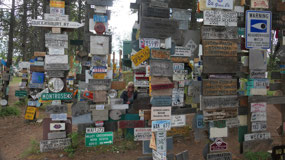

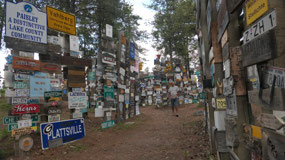
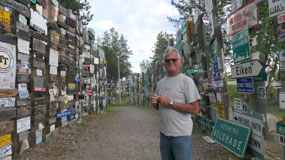
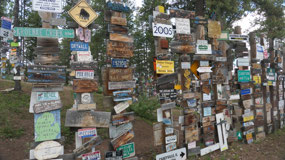
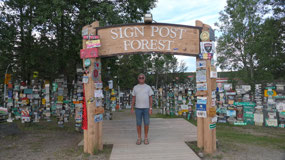
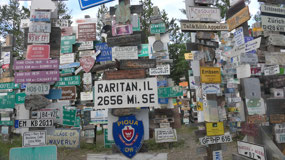

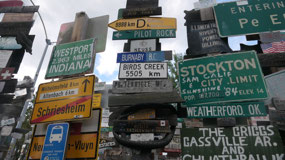
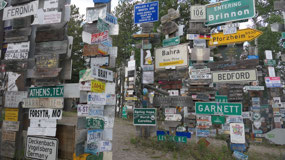
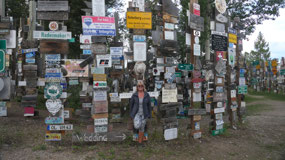
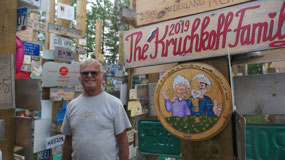
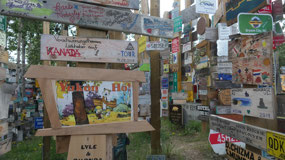
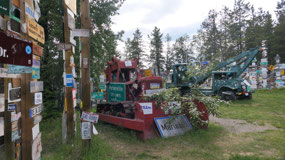
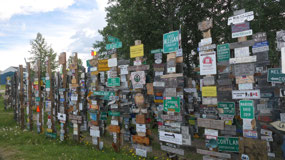
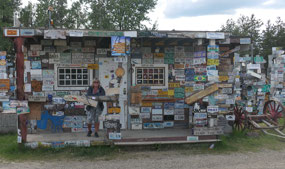
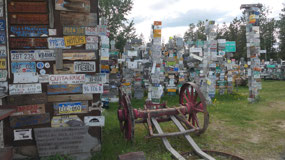
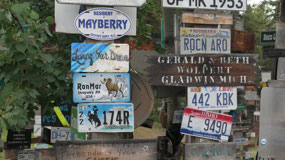
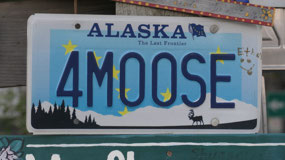
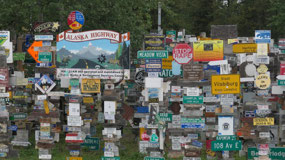
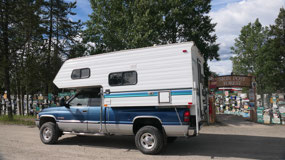
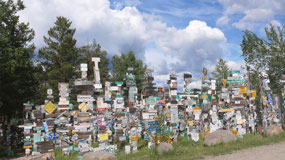
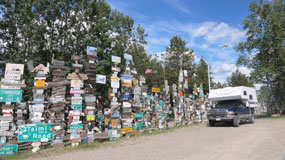
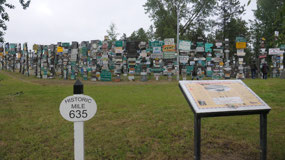
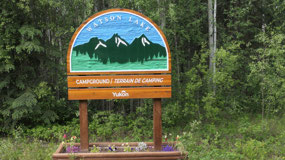
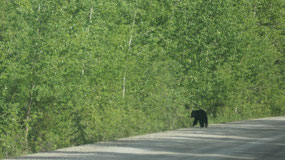
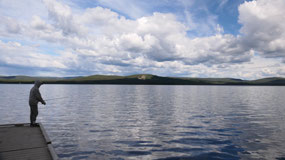
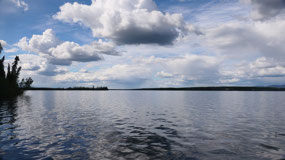

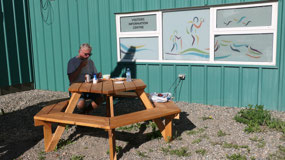
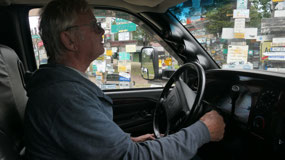
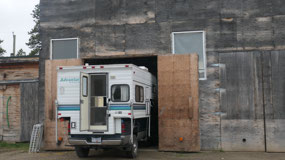
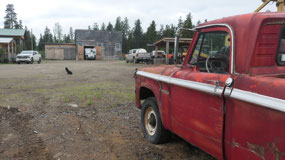
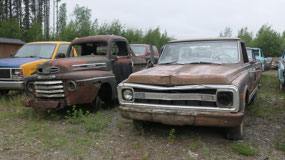
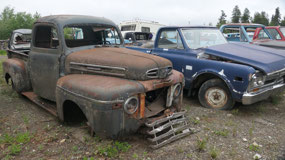
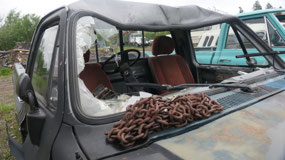
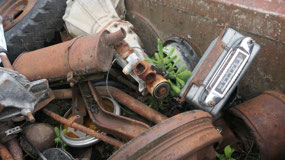
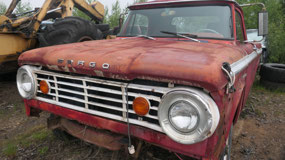
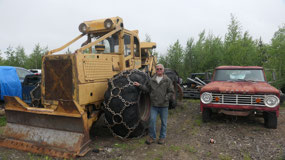
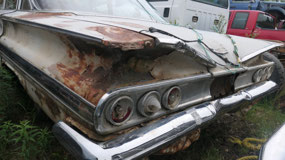
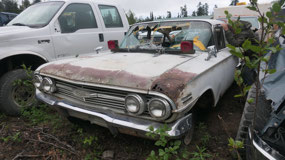
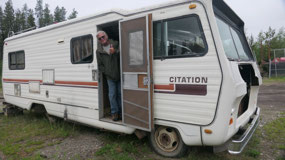
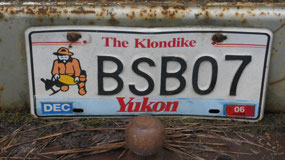
2025-05-22